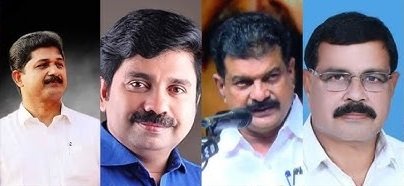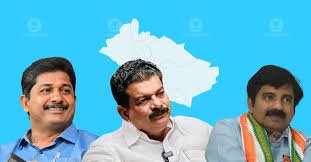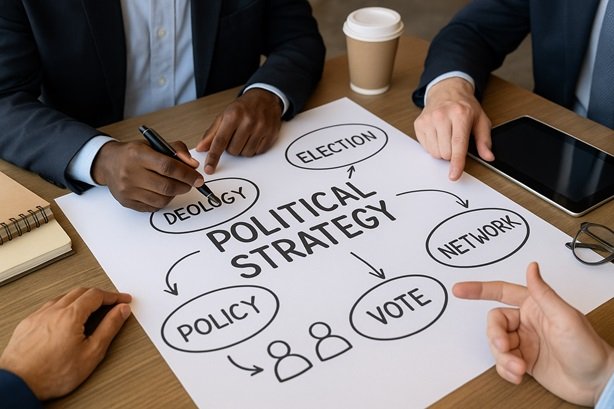
Forcast by Aaron Election Strategy Consultant
The four main candidates of the Nilambur bypoll (from left) – M. Swaraj (LDF), Aryadan Shoukath (UDF), P.V. Anvar (TMC) and Mohan George (BJP).
The UDF candidate Aryadan Shoukath is projected to win the Nilambur by-election by 5,000 to 15,000 votes, based on voter sentiment, historical voting patterns, and Muslim vote consolidation.
However, if the LDF effectively utilizes Election Strategy Services, it could turn the UDF’s dreams upside down.
Key dynamics favoring UDF include a strong anti-incumbency mood against the ruling LDF as well as aginst PV Anvar. UDF’s candidate Aryadan Shoukath also benefits from “Aryadan Mohammed’s” legacy and has consolidated Muslim support via the Jamaat-linked Welfare Party endorsement.
Muslim voters (46% of electorate) are pivotal: historically a Congress/Muslim League bastion (Aryadan’s stronghold), they are now split among UDF, LDF and Anvar. Shoukath has campaigned as Aryadan’s moderate heir and won Welfare Party support, while LDF fields Swaraj as a secular alternative.
Hindus (40–45%) – including plantation “settlers” – are divided: some back the Congress/IUML network, others the CPM’s welfare agenda, and BJP/TMC are newly courting dissatisfied settlers.
Christians (<8%) are a small swing group; BJP’s Mohan George is targeting them with a development message, while UDF/LDF stress minority welfare and secular credentials.
Geographically, the hill panchayats (Amarambalam, Edakkara, Karulai, Pothukal, Vazhikkadavu) are rural/tribal areas where LDF was strong in 2021 (e.g. Amarambalam: LDF 11,238 vs UDF 9,746) In 2025 the LDF retains solid ground networks here, but faces anti-incumbent backlash on issues like wildlife conflict – PV Anvar is explicitly appealing to these grievances.
By contrast Moothedam (a Christian-settler panchayat) is UDF-leaning (UDF won 2021 by 2,331 votes there). Nilambur town (municipality) – with many government employees and businesses – narrowly went LDF in 2021 (13,200 vs 11,673) and remains a tight contest focused on infrastructure and services. Overall 2021 was a razor-thin LDF win (LDF 46.9% vs Congress 45.34%in 2025 the three-way split (LDF vs UDF vs Anvar/TMC, plus BJP) creates uncertainty, but current trends favor UDF.
Voter Segmentation by Religion
- Muslim voters (43%-46%): Once solidly in Aryadan’s Congress/IUML column, now contested by all frontsShoukath’s “Aryadan” pedigree and WPI backing are rallying Islamic and moderate votes to UDF. LDF counters by promoting Swaraj as an “anti-fascist secular” choice for disaffected Muslims. PV Anvar retains personal clout among a subset of Muslims. In short, Muslims are split three ways (UDF vs LDF vs Anvar) and will decide the outcome.
- Hindu voters (40%–45%): A mixed group including tea/rubber plantation settlers and urban workers. In 2025 both BJP and Anvar explicitly target settlers with anti-establishment messaging. BJP’s narrative (“Modi’s development agenda”) is aimed at young or dissatisfied Hindus, while UDF leans on Aryadan’s secular-Hindu legacy and IUML alliances. LDF emphasizes its social-welfare record to keep core Hindu supporters. Key issues: farm income, jobs and rural infrastructure. We expect Hindu votes to fragment: a solid minority will back Congress/LDF, while a growing segment may shift to BJP/Anvar.
- Christian voters (<8%): Traditionally divided between Congress and the Left, but now hotly contested. BJP’s Mohan George (a Christian) hopes to grow BJP’s share from its ~5% 2021 base. UDF highlights its minority-friendly policies; LDF proclaims secularism and development. Church-related concerns (education, social services) matter. All fronts will work these pockets; no clear favorite exists, making Christian votes a wild card in close wards.
Voter Segmentation by Different Groups of all religion
- Migrant settlers (plantation/tribal workers): A unique bloc in the hilly Grama Panchayaths. These voters face economic hardship and environmental. PV Anvar explicitly courts them as victims of “anti-people” LDF policies. Historically both UDF and LDF have competed for settlers by promising agricultural and road development. In 2025, settlers are split: some drawn to Anvar’s protest pitch, others to LDF’s cadre networks or UDF’s welfare schemes. Their impact is concentrated in rural booths, where small swings can flip results.
- Government employees and pensioners: A well-organized, educated group. Traditionally pro-Left (via unions) but many also have Congress links. The UDF is attacking LDF on pension delays and alleged fund misuse, while LDF defends its welfare record. If pensioners turn out against LDF, it could magnify UDF’s lead; if not, LDF could retain urban votes.
- Urban vs Rural (Town vs Panchayats): Urban Nilambur’s voters (town/muncipality) care about roads, water and services. LDF currently leads urban areas (e.g. Nilambur town was +1,527 for LDF in 2021), but UDF hopes development pledges will close the gap. In the rural “hills” (the five Grama Panchayaths like Edakkara, Karulai, etc.), the LDF held a lead in 2021 (Amarambalam LDF+1,492; Karulai LDF+1,446). In 2025 these wards are competitive: UDF candidates have local ties (e.g. Shoukath is ex-chair of Nilambur municipality) and are highlighting failures like the recent wildlife electrocution case. In sum, Nilambur town is a battleground and hilly panchayats slightly lean LDF – but both are within striking distance of UDF.
Trends (2021 vs 2025)
In 2021, LDF-backed Independent P.V. Anvar won by just ~2,700 votes (46.90% vs Congress’s 45.34%). Aryadan’s Congress had long dominated this seat so 2021 was a major upset. The very narrow margin shows Nilambur is volatile: most panchayats were close.
By 2025, the mood has shifted sharply. An online survey finds strong anti-incumbency: 45% of voters say state govt performance will drive their vote (60% of those rate it “poor”). Wildlife attacks (wild boars, elephants) are also high on minds, with 47.5% blaming the LDF’s inaction. These national and local dissatisfaction signals favor UDF. On the other hand, Shoukath enjoys high personal approval (87.5% of respondents rated him “excellent/good” or “average”, despite Anvar’s campaign to discredit him. In short, compared to 2021’s personality-driven local contest, 2025 is dominated by reactions to state government performance, which currently benefits the UDF.
Forecast & Risks
Aaron Election Strategy’s models project a UDF victory margin of order 5–15k votes. This accounts for expected leads in UDF-favorable wards (e.g. Moothedam, Nilambur town) outweighing LDF strengths in other areas. However, this outcome faces several risks:
- Vote Splitting by PV Anvar (TMC): Anvar has pledged “unconditional” support to UDF conditionally (favoring VS Joy), effectively running as a spoiler. His criticism of Shoukath could fragment the UDF/Muslim vote instead of consolidating it. If Anvar pulls even a few thousand votes from Shoukath’s base, it could cut the predicted UDF margin or even change the winner in close booths.
- UDF Internal Unity: The party survived an internal tug-of-war to nominate Shoukath, but frustrations linger. If UDF factions (like those loyal to Anvar-backed Joy) withhold full support, turnout among Congress cadres might dip. Any disunity would reduce the edge needed to counter LDF’s organization.
- LDF Counter-Mobilization: The CPM has a disciplined ground game. They are already attacking UDF’s Islamic backing as “communal” – CPM sec. MV Govindan warned “UDF has become an alliance of communal forces. This narrative could rally non-Muslim supporters. Also, the LDF continues to highlight its welfare record (pensions, subsidies) to motivate core voters. If the LDF gets its base fully to the polls, the UDF lead could shrink.
- BJP/Minor Parties: While BJP is a minor player here, its candidate’s appeal to Christians and change-seekers could slightly erode UDF or LDF votes in critical booths. This effect is a swing variable in a tight race. Other fringe groups (e.g. SDPI) may also draw small votes unpredictably.
- Local Issues & Turnout: Unforeseen local developments (flood relief effectiveness, a wildlife incident, etc.) could sway sentiment late. Voter turnout patterns could diverge from 2021 – for example, if minority turnout surges or LDF’s base is demotivated, the result could widen; the opposite swing is also possible.
Strategic Recommendations
- Booth-Level Analytics: Use detailed past-election and survey data to classify booths as safe, favorable, battleground or difficult. Identify key booths where a few hundred votes can flip outcome. For each booth, profile demographics (e.g. % Muslim, settler households, first-time voters) and past swings. Deploy resources (door-knock teams, calling campaigns) preferentially in contested booths, converting “favorable” booths into “safe” and neutralizing “battleground” ones.
- Micro-Targeted Outreach: Tailor messages to specific communities. For Muslim voters, emphasize Shoukath’s moderate legacy and UDF’s track record on minority issues (capitalizing on the WPI’s network for door-to-door calls and family meetings). For Hindu-settlers, highlight Congress pledges on agriculture and forest-based livelihoods. Use WhatsApp groups and local radio to send targeted videos/scripts on issues like pensions or farm subsidies. Big-data tools (like those used by major parties) can micro-target demographic groups with customized ads and handouts.
- Influencer Engagement: Engage local religious and community leaders. Coordinate with the Welfare Party and IUML imams to campaign for Shoukath at mosques and on community platforms. Meet church pastors and Kerala Congress-B leaders to ensure Christian outreach. Involve retired government officials and Panchayat chairs in public forums. Grassroots influencers (school teachers, panchayat members, youth organizers) at the booth level should be briefed to advocate UDF points and reassure communities on sensitive issues.
- Narrative Control in Swing Areas: In mixed wards (e.g. Nilambur town, Chungathara), dominate the narrative. Emphasize UDF’s solutions: e.g. quicker bridge repairs after floods, compensation for crop losses, improved tribal welfare. Aggressively counter any “UDF communal” line by reminding voters of Pinarayi Vijayan’s own past engagement with Jamaat leadership and contrasting that with BJP’s Hindutva shift. Use social media to preempt fake news. Rapidly address any incidents (like animal attacks) by showing candidate visits or public appeals. Maintain a disciplined message: “Vote for change in governance, not for divisive politics.”
By combining data-driven targeting with ground-level outreach and positive storytelling, the UDF can capitalize on current momentum and mitigate risks. Properly executed, these tactics should help deliver the projected UDF win in Nilambur.



